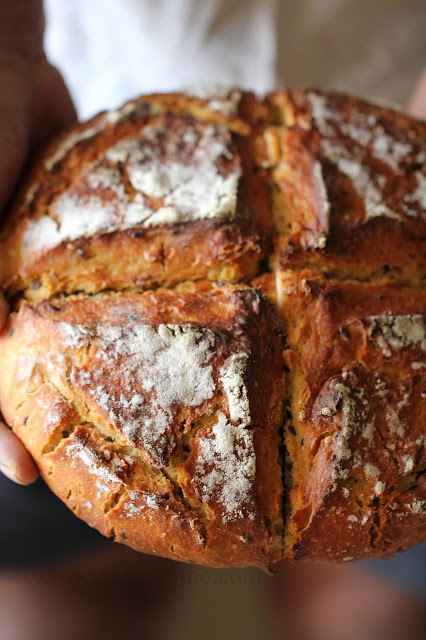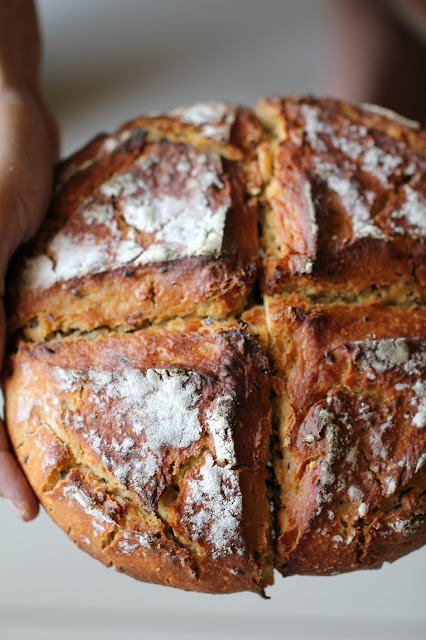I have to upfront declare that I'm not an expert in bread baking. I have had multiple failed attempts in bread baking until I found this easy easy no knead bread recipe off the internet. The original recipe called for double the quantity of ingredients and some other things. However, I tweaked it a bit to our taste and liking with every attempt and eventually I have stuck to this tweaked recipe. It requires no kneading and uses no special ingredients, equipment or techniques. It takes very little effort — only time. You will need 24 hours to create the bread, but much of this is unattended waiting, a slow fermentation of the dough that results in a perfect loaf.
This is just the simplest kind of bread you can make. You basically throw everything into a bowl and mix it up, then sit around, let the yeast do its work, and bake it. But it’s not just a bread for beginners — those who bake frequently also really love a no knead bread. The slow rise gives this bread great flavor, and the baking method gives it an awesome crispy crust. It’s artisan quality with very little effort — that’s why it is so popular!
I’m obsessed with seeds and grains in general, and always find them delicious in a bread while they bring additional fiber to the whole bread. In a word, there are only good reasons to add seeds in your food. Multiseed bread is perfect for breakfast, served with butter and jam for instance, but it also works beautifully with cheese or any other savory spread.
When it comes to the choice of seeds, feel free to use the ones you like most or have at hand, as there is no specific rule. I personally like to use pumpkin, flaxseed and sesame seeds.
Ingredients:
220 gms whole wheat flour,
220 gms all purpose flour,
320 ml lukewarm water
10 gms yeast
10 gms salt
35 gms seeds of your choice - I used melon, flaxseed, & walnuts
2 tbsp sourdough discard (optional)
Method:
I’m obsessed with seeds and grains in general, and always find them delicious in a bread while they bring additional fiber to the whole bread. In a word, there are only good reasons to add seeds in your food. Multiseed bread is perfect for breakfast, served with butter and jam for instance, but it also works beautifully with cheese or any other savory spread.
When it comes to the choice of seeds, feel free to use the ones you like most or have at hand, as there is no specific rule. I personally like to use pumpkin, flaxseed and sesame seeds.
Ingredients:
220 gms whole wheat flour,
220 gms all purpose flour,
320 ml lukewarm water
10 gms yeast
10 gms salt
35 gms seeds of your choice - I used melon, flaxseed, & walnuts
2 tbsp sourdough discard (optional)
Method:
- Add the yeast into the lukewarm water, mix with a spoon and set it aside for 10 mins.
- In a large mixing bowl, add the flours, salt, and seeds together until mixed.
- Stir in the water and sourdough discard (if using)
- The dough will look and feel sticky and thats fine. The natural tendency is to add more flour, but dont do that.
- Scrap off the dough from the mixing bowl and tip it into a large airtight container.
- Place this container in the refrigerator overnight.
- Next day bring the dough to room temperature before prepping for baking.
- Preheat the oven to 220 degrees for 15 mins.
- Lay a parchment paper on the baking tray and place another baking tray filled with water inside the oven.
- Remove the dough from the container and gently shape into a ball with your hands.
- Place the dough on the baking tray lined with parchment paper (the dough will look a little bit sticky and messy but it’s normal, just let it be).
- Sprinkle extra seeds on top, and bake 30 minutes.
- After 30 mins, increase the temperature to 230 degrees and bake for another 10-15 minutes to get the outside crust golden brown and crispy.
- Transfer onto a cooling rack, and let cool.
Serving and Storing No-Knead Bread
Once out of the oven, let the bread cool for at least an hour before slicing and serving. Any bread not slathered in butter and devoured immediately should be tightly wrapped and stored at room temperature where it keeps well for about three days. It can also be tightly wrapped in plastic wrap and foil and frozen for up to 3 months.
Did you make this recipe?
Please let me know how it turned out for you! Leave a comment below and share a picture on Instagram with the hashtag #thefitdotme







Comments
Post a Comment
Thanks for visiting my blog. I appreciate your feedback and/or suggestions!!